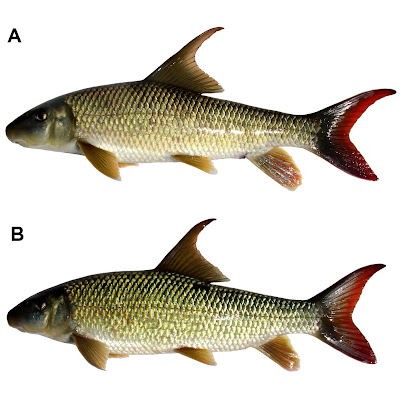 |
| Moxostoma ugidatli Jenkins, Favrot, Freeman, Albanese & Armbruster, 2025 |
Abstract
The Sicklefin Redhorse is perhaps the largest truly new North American species discovered in the last century, and the species is herein described as Moxostoma ugidatli, new species. Sicklefin Redhorse differ from other red-tailed redhorse based on the presence of elongate first through third dorsal-fin rays, and from all other redhorse by having plicate lips with deep, branching grooves distally (vs. lips papillose or unbranching) and by having moderately molariform pharyngeal teeth (vs. molariform or chisel-like teeth). The Sicklefin Redhorse is found in the upper Tennessee River basin of North Carolina and Georgia in the Little Tennessee and Hiwassee River subbasins. Although the species is not federally protected, it is threatened in North Carolina and endangered in Georgia. The species is known to live to 22 years, with the largest preserved female 500 mm SL, 633 mm TL, 2.561 kg and the largest preserved male 463.2 mm SL, TL unknown, 2.024 kg.
 |
| Live specimen of male, 353 mm SL (A) and female, 350 mm SL (B) Moxostoma ugidatli, AUM 86445, by S. Fraley. |
Moxostoma ugidatli, new species
Sicklefin Redhorse or Ugidatli (ᎤᎩᏓᏟ)
Diagnosis.—Moxostoma ugidatli can be separated from all other Moxostoma by having a moderate to strongly falcate dorsal fin where the first 1–3 rays of the dorsal fin generally extend beyond the last dorsal-fin ray when adpressed (vs. straight to moderately curved dorsal fin with first dorsal rays not extending beyond last dorsal-fin ray when adpressed; Figs. 1, 2) and by having plicate lower lips that branch distally and exhibit deeply branched grooves and deeply transected ridges, particularly posteriorly (vs. papillose lips or plicae that do not branch; Fig. 4). In addition, M. ugidatli can be separated from all other Moxostoma by having moderately molariform teeth on the lower portion of a heavy pharyngeal arch (vs. chisel-like teeth on a light arch in most Moxostoma and highly molariform teeth on a heavy arch in M. carinatum, M. hubbsi, and M. robustum; Fig. 3). Moxostoma ugidatli can be further separated from M. anisurum, M. ariommum, M. austrinum, M. cervinum, M. collapsum, M. congestum, M. duquesnei, M. erythrurum, M. hubbsi, M. lachneri, M. pappillosum, M. rupiscartes, and the undescribed Apalachicola Redhorse, Brassy Jumprock, and Carolina Redhorse by having a red caudal fin (vs. gray to nearly black caudal fin with maybe a slight red or wine-colored tinge as in co-occurring populations of M. duquesnei).
Etymology.—ᎤᎩᏓᏟ or ugidatli (pronounced ooh-gee-dacht'lee) is the Cherokee word for the species and means it wears a feather in reference to this being the only species in the region where the dorsal fin is exposed above the water when spawning and its feather shape. Dr. Bob Jenkins had originally proposed a species name based on the falcate fin “falcatus” and used this in reports and correspondence; however, it is a nomen nudum. We felt it important to honor the Cherokee name as it occurs on the unceded territory of the Eastern Band of Cherokee Indians and it is right and proper to refer to the species using the name spoken by its true discoverers. Treated as a noun in apposition. Sicklefin refers to the moderately to extremely falcate shape of the dorsal fin.
Robert E. Jenkins, Scott D. Favrot, Byron J. Freeman, Brett Albanese and Jonathan W. Armbruster. 2025. Description of the Sicklefin Redhorse (Catostomidae: Moxostoma). Ichthyology & Herpetology. 113(1); 27-43. DOI: doi.org/10.1643/i2024049 (18 February 2025)